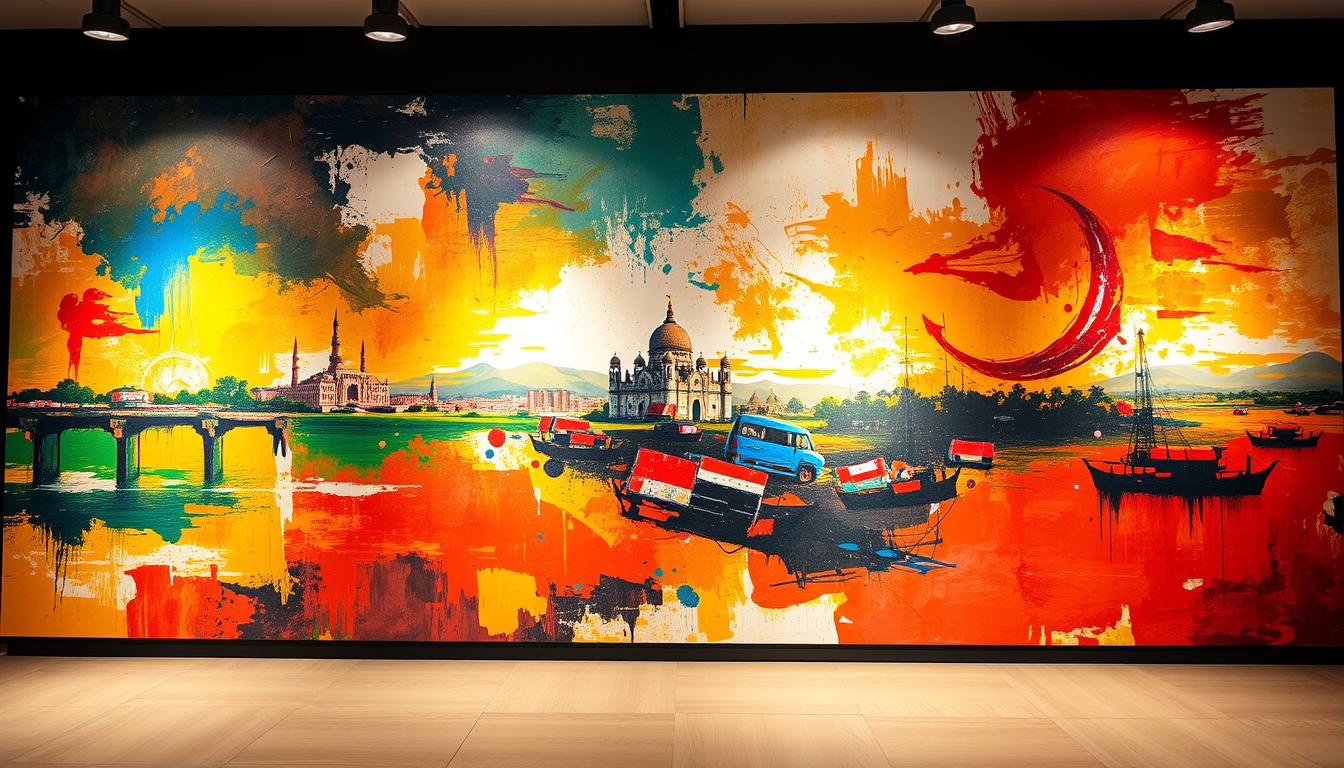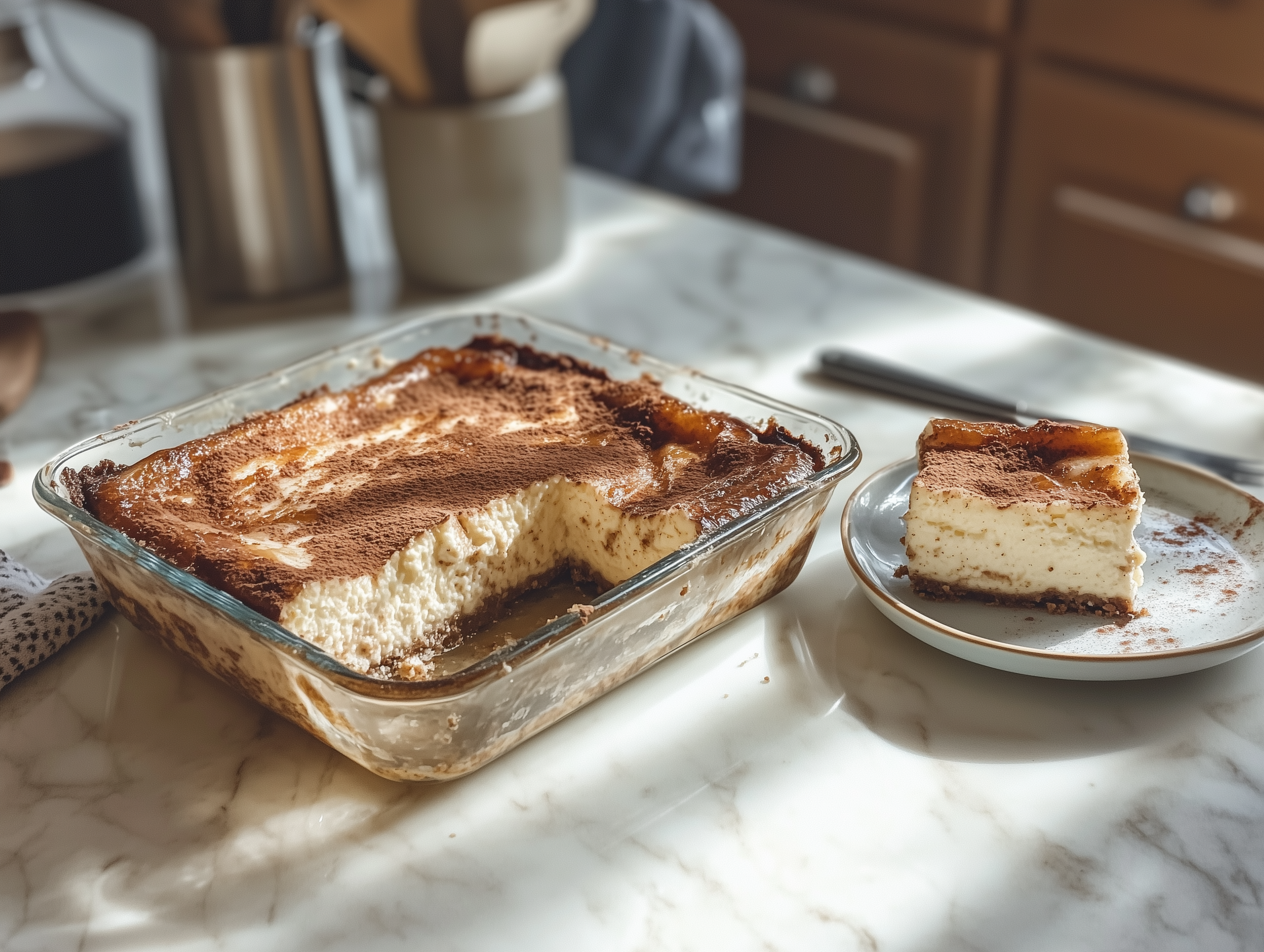When I walked into the gallery, I was hit with the bright colors and detailed patterns of modern Indian art. It took me to a world full of cultural depth and new artistic ideas. Exploring contemporary Indian artists has been amazing, showing a mix of old traditions and fresh creativity.
Modern Indian art is a special mix of old and new. It starts with traditional styles like Warli and Madhubani paintings. Then, it moves to the bold works of today’s artists, showing India’s rich cultural story.
Today’s Indian artists are pushing the limits of art, mixing old methods with new views. Their art tells stories of change, social issues, and staying strong through tough times. This makes modern Indian art a big deal worldwide, touching hearts far and wide.
Key Takeaways
- Modern Indian art bridges traditional and contemporary artistic expressions
- Contemporary Indian artists draw inspiration from diverse cultural experiences
- Artistic techniques range from ancient traditional methods to experimental approaches
- Global audiences are increasingly appreciating the depth of Indian artistic narratives
- Each artwork represents a unique cultural conversation
What is Modern Indian Art?
Modern Indian art is a blend of old traditions and new ideas. It tells the story of India’s cultural change. It moved away from old styles and found new ways to express itself.
The world of modern Indian art has seen big changes:
- Artists rejected old styles
- They started using modern art from around the world
- They mixed old techniques with new ideas
Historical Context of Artistic Transformation
The start of modern Indian art is tied to important moments in India’s past. The Progressive Artists’ Group, formed in 1947, was key. Artists like Francis Newton Souza and Maqbool Fida Husain changed how art was seen.
Key Movements and Artistic Trends
Many important movements shaped modern Indian art:
- The Bengal School of Art started in the late 19th century
- Artists challenged old views with new ones
- They were influenced by European modern art
Artists like K.G. Subramanyan mixed art with popular culture and folk traditions. This made modern Indian art rich and meaningful, both at home and worldwide.
Influential Modern Indian Artists
The world of contemporary Indian artists is full of creativity and innovation. Modern Indian paintings have changed a lot. They now challenge old ways and speak to people all over the world.
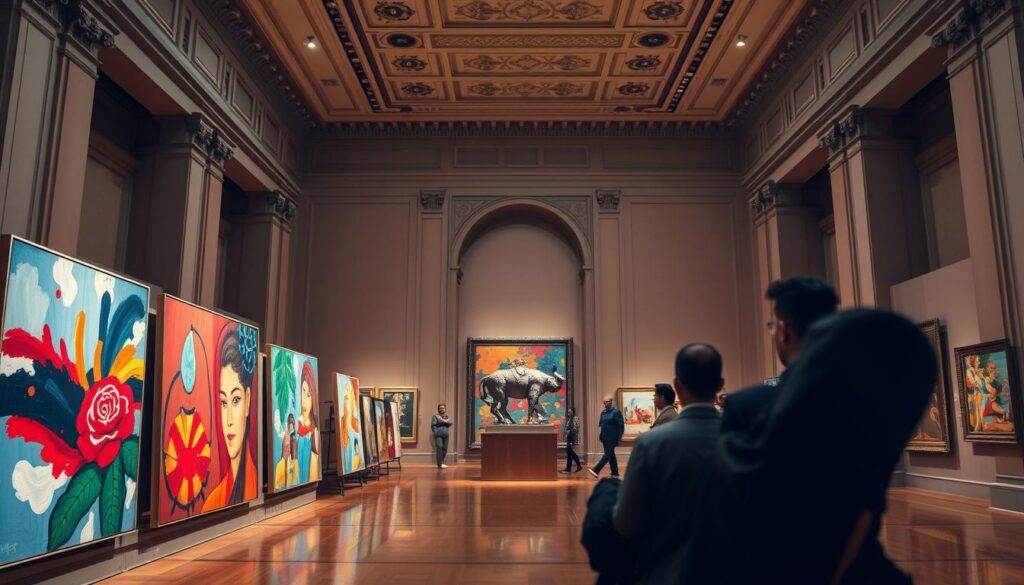
Exploring influential modern Indian artists shows us amazing people who changed art. Their work shows the heart of India’s complex culture.
F.N. Souza: A Pioneering Visionary
F.N. Souza was a groundbreaking artist who pushed boundaries with his bold style. His paintings questioned society and showed human weakness. Souza’s work changed modern Indian paintings and inspired many.
Nandalal Bose: Bridging Tradition and Modernity
Nandalal Bose was key in Indian art history. He mixed traditional techniques with modern views. His work kept cultural stories alive through art.
- Traditional Indian artistic techniques
- Modern aesthetic sensibilities
- Cultural preservation through visual storytelling
Tyeb Mehta: Exploring Human Emotion
Tyeb Mehta was a major figure in contemporary Indian art. His iconic “Diagonal” series showed deep human experiences. Mehta’s art is more than just pictures; it’s a powerful emotional journey.
These artists show the amazing variety and depth of modern Indian art. Each one adds something special to the growing tradition of art.
Themes in Modern Indian Art
Modern Indian art is a vibrant mix of culture, social awareness, and spiritual search. Artists turn old stories into strong visual talks that reach people worldwide.
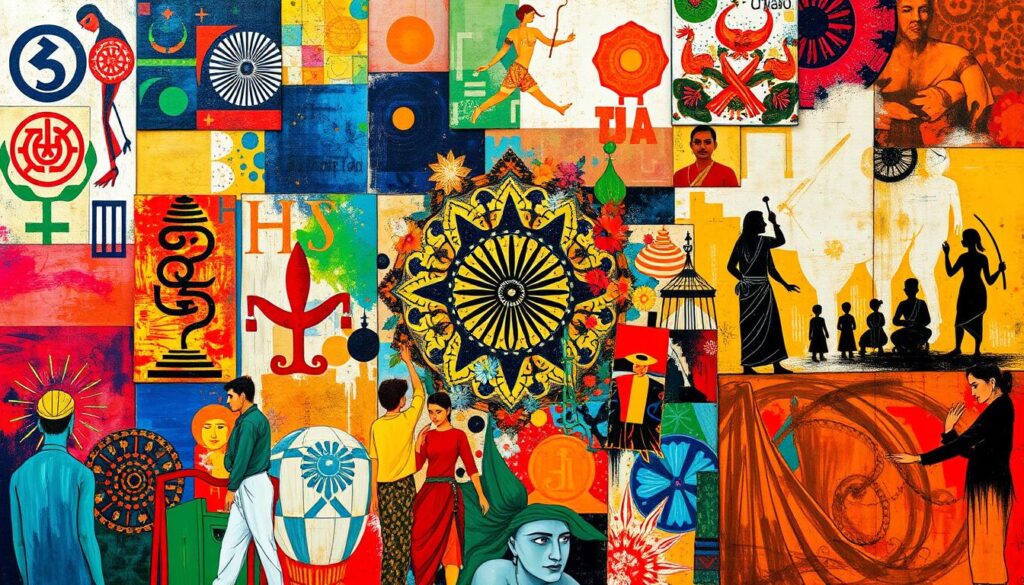
This art form dives into many deep themes. These themes show the complex culture of India:
Cultural Identity and Globalization
Artists like Anju Dodiya give new life to old symbols. They explore deep emotional spaces. Hindu and Buddhist iconography connect personal stories with the world.
- Reimagining traditional Rajasthani miniature paintings
- Integrating meditative practices into contemporary installations
- Creating visual narratives that transcend cultural boundaries
Social Issues and Activism
Today’s Indian artists speak out through their art. They question old stories and bring up big social issues. They tell these stories in a way that grabs attention.
Art becomes a vehicle for transformative social discourse.
Nature and Spirituality
Spiritual ties are a big part of modern Indian art. Artists like Rupali Patil use mandalas to show the link between the physical and spiritual worlds.
- Exploring philosophical concepts through visual representation
- Connecting traditional spiritual practices with contemporary art forms
- Creating immersive experiences that transcend cultural boundaries
These themes show how modern Indian art keeps growing. It reflects both its rich history and today’s global views.
Techniques and Mediums in Modern Indian Art
Modern Indian paintings mix old techniques with new ideas. Artists are making traditional art styles come alive in exciting ways. They turn old practices into fresh, lively expressions of creativity.
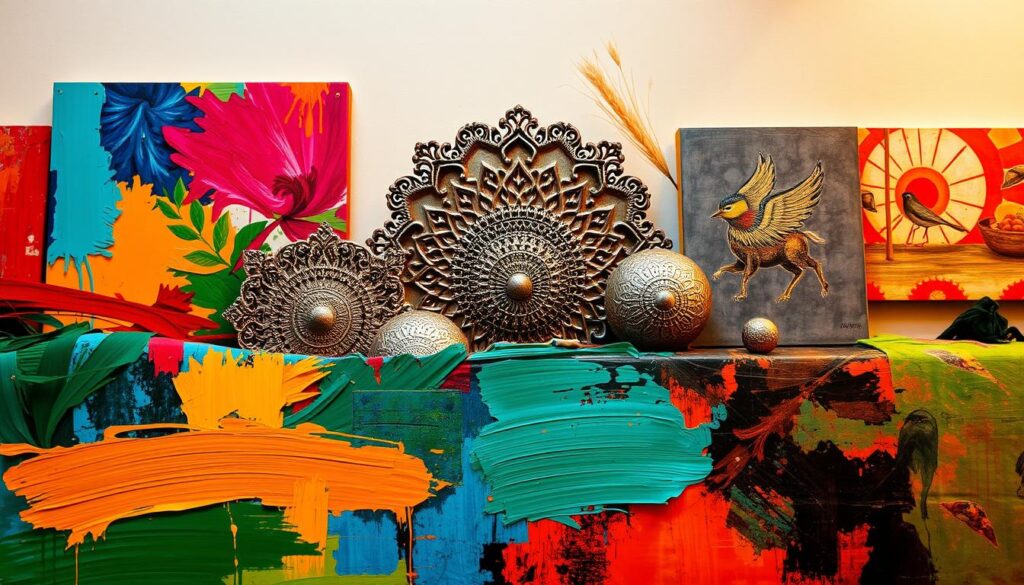
Traditional Indian art has changed a lot in recent years. Artists are trying new things and pushing the limits of what art can be.
Traditional Techniques Reimagined
Many traditional art forms have been updated for today:
- Warli art now uses canvas instead of mud walls
- Madhubani paintings explore modern themes while preserving detailed designs
- Gond artists have moved from natural pigments to acrylic paints
- Miniature painting techniques are being used on digital platforms
Experimental Mixed Media Approaches
Contemporary Indian artists are mixing different techniques. Pseudorealism, a new genre by Devajyoti Ray, combines abstract Indian art with modern themes.
Artists like Nandalal Bose and Benode Behari Mukherjee have led the way. They mix traditional methods like wash and tempera with today’s ideas. This mix creates art that connects with both cultural roots and global experiences.
The growth of modern Indian paintings keeps surprising us. It offers new views on art and cultural identity.
The Role of Galleries and Exhibitions
The world of modern Indian art is alive thanks to galleries and exhibitions. These places connect artists, collectors, and fans from all over the world.
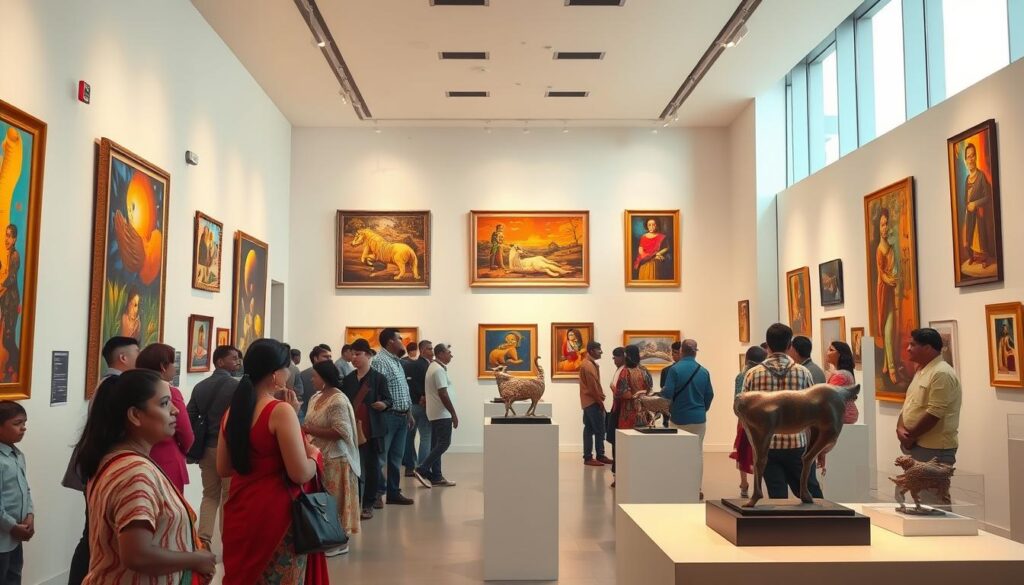
Galleries are key in promoting and keeping Indian art alive. They offer spaces for creativity to grow and for stories to be told. I’ve learned a lot about how they support modern Indian art.
Prominent Galleries in the United States
Many important Indian art galleries have made a mark in the United States:
- The Kiran Nadar Museum of Art teamed up with the Guggenheim Museum
- Experimenter Gallery from Kolkata hosts digital exhibitions
- National Gallery of Modern Art connects with global platforms
Major Exhibitions Spotlighting Indian Art
Curated shows have helped share modern Indian art with the world. The Kochi-Muziris Biennale, starting in 2012, was a big step in showing off contemporary Indian art.
Digital platforms have changed how we see and collect Indian art. Now, rare pieces are more reachable than ever.
From online shows to global art fairs, these events tell powerful stories about modern Indian art. They link different cultures and artistic views together.
The Global Impact of Modern Indian Art
Modern Indian art has changed the world of art, crossing cultural lines and grabbing global attention. The journey of contemporary Indian artists is inspiring, telling a story that reaches far and wide. Artistic innovations have put Indian creativity in the spotlight.
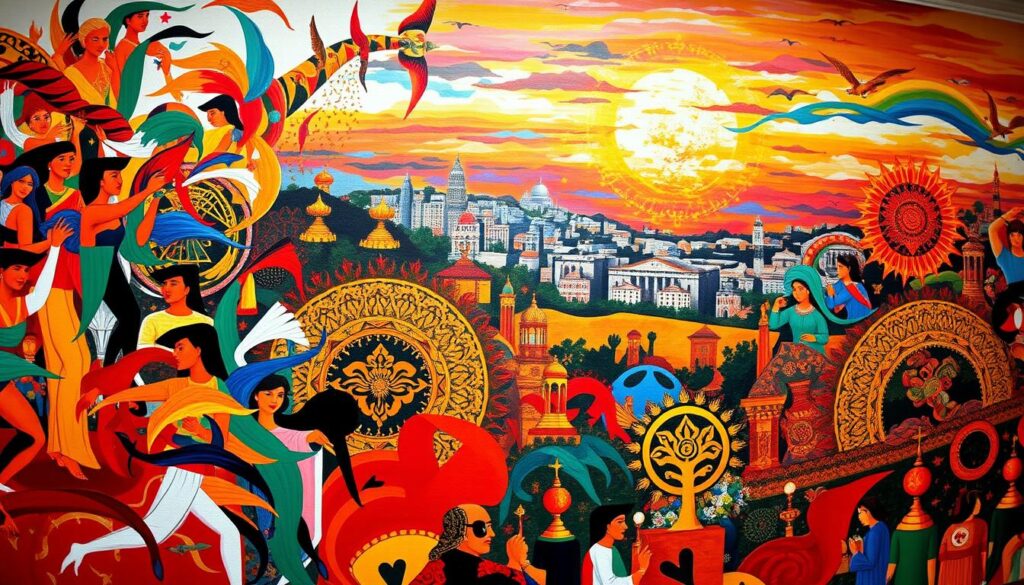
Modern Indian art is special because it mixes old techniques with new views. Artists like Subodh Gupta and Jitish Kallat are now known worldwide. They show the power of contemporary Indian artists.
International Art Scene Transformation
The influence of modern Indian art goes beyond borders. Key moments include:
- More Indian art in international galleries
- Big sales of Indian art at auctions
- Indian artists in global biennales and shows
Collaborative Global Artistic Dialogues
International teamwork has helped spread the word about modern Indian art. These partnerships link different art traditions, leading to deep cultural sharing.
Indian artists are not just participants but active shapers of the global artistic narrative.
The 1991 economic changes helped artists show their work worldwide. This opened doors for contemporary Indian artists to share their creativity globally.
Collecting Modern Indian Art
Exploring modern Indian paintings is thrilling for both art lovers and investors. The Indian art scene is full of creativity, cultural depth, and investment chances.
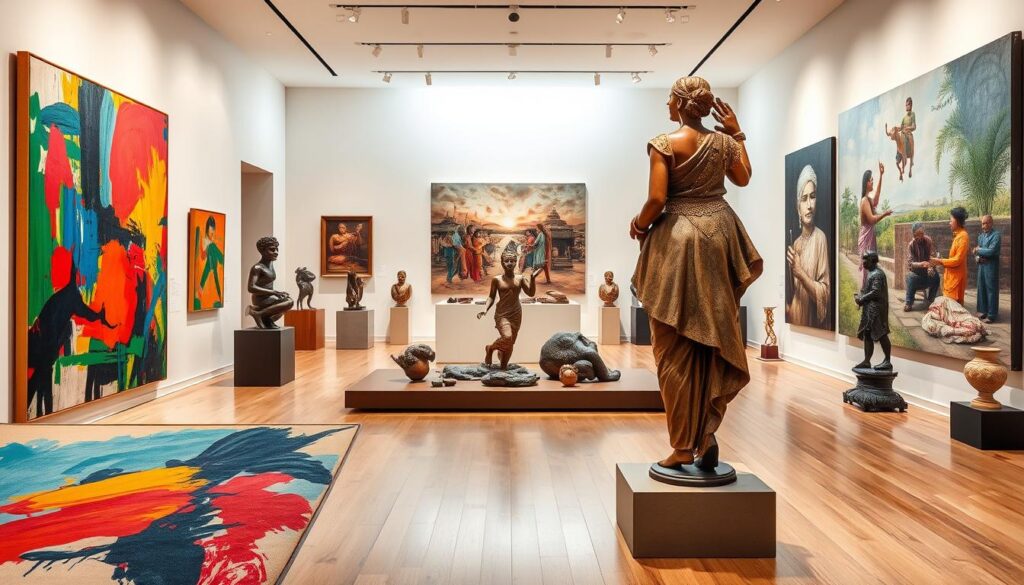
As an art collector, I’ve found that building a collection is more than just buying art. It’s about creating a story with your pieces.
Tips for First-time Collectors
Here are key tips for starting your modern Indian art collection:
- Choose quality over quantity
- Look for emerging and mid-career artists
- Understand the artwork’s cultural background
- Connect with trusted galleries
Evaluating Artworks and Authenticity
Exploring the Indian art market needs careful thought. Here’s what I suggest:
- Check the artwork’s history
- Get expert appraisals
- Learn about the artist’s reputation
- Think about the artwork’s future value
Collecting art is about finding pieces that speak to you.
Successful collectors like Anurag Khanna focus on meaningful connections. He looks for mid-career artists from the 1960s and younger. He values key works that share deep stories, not just following trends.
The Indian art market is growing, with great chances for collectors who dive in with passion and dedication.
Challenges Facing Modern Indian Artists
The journey of Contemporary Indian artists is filled with complex obstacles. These challenges test their creativity and resilience. They must navigate the Indian art market with exceptional skill, beyond just artistic talent.
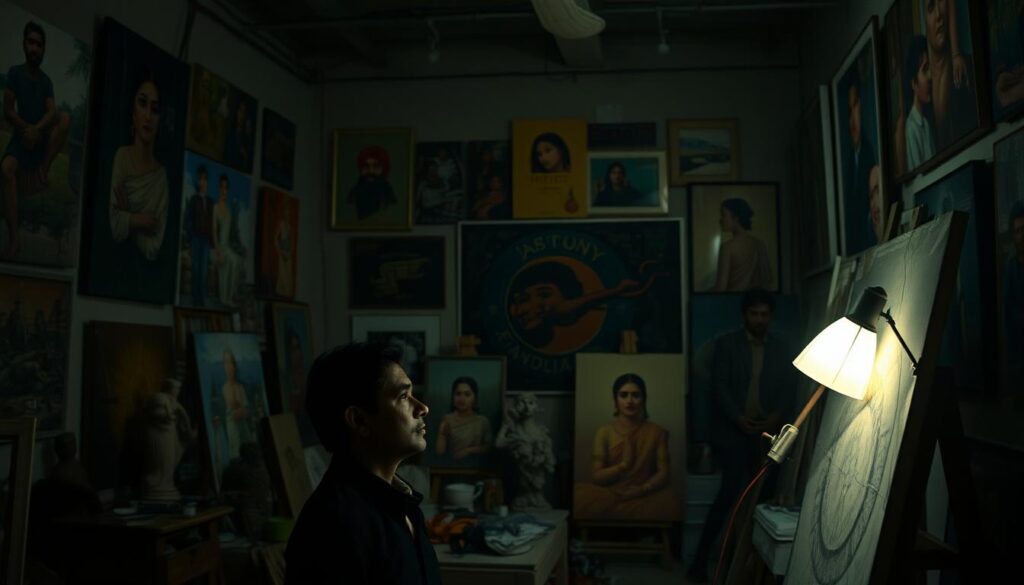
Artists face many challenges in the economic, cultural, and professional areas. Their journey is about finding a balance between traditional heritage and global artistic expressions.
Economic Barriers in Artistic Pursuits
The economic landscape for Contemporary Indian artists is tough:
- Limited financial support from national institutions
- High production costs for art materials
- Minimal government grants for emerging artists
- Restricted access to international art markets
Navigating Global Art Platforms
Breaking into the global Indian art market requires strategy. Digital platforms like RtistiQ are key, connecting local artists with international collectors.
The true challenge lies in maintaining artistic authenticity while appealing to diverse global audiences.
Artists like Bhupen Khakar showed that challenging traditional boundaries can open new opportunities. Their blend of personal expression and cultural narratives inspires new talents.
Cultural and Institutional Challenges
Contemporary Indian artists must balance:
- Preserving traditional artistic techniques
- Embracing modern artistic movements
- Addressing complex social narratives
- Developing global market strategies
By understanding and overcoming these challenges, Contemporary Indian artists continue to shape the global artistic scene. They bring their unique perspectives to international platforms.
Resources for Exploring Modern Indian Art
Exploring modern Indian art is an exciting journey. I’ve put together a guide to help you dive into this vibrant world. You’ll find resources and platforms to explore.
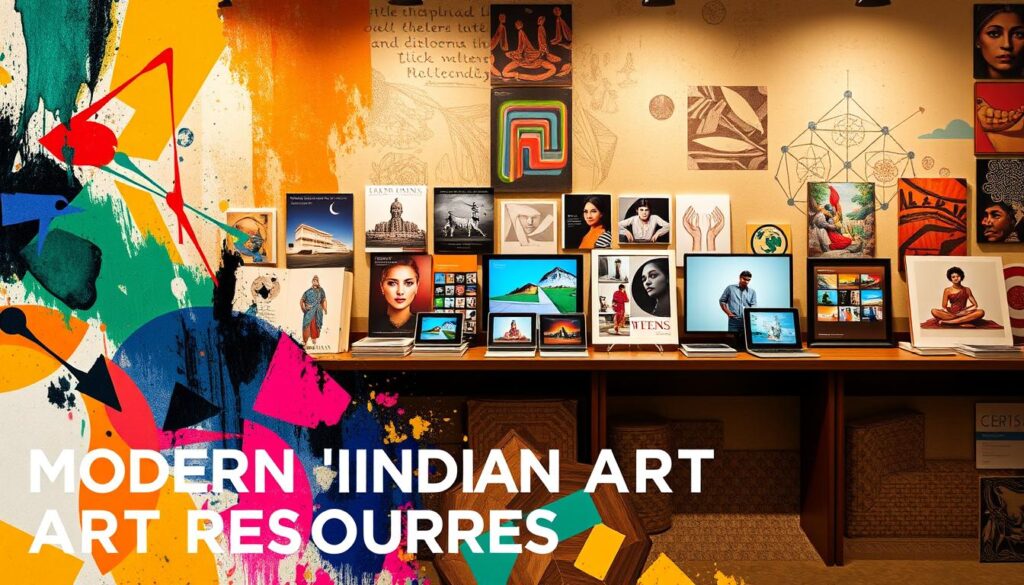
Essential Books and Documentaries
To understand modern Indian art better, check out these resources:
- “Modern Masters of Indian Art” – A pocket gallery publication that offers insights into key artists
- “Jadupat: The Living Arts Tradition” – An in-depth exploration of Indian artistic heritage
- Documentaries featuring the Progressive Artists’ Group and their revolutionary approach to Indian art
Online Platforms and Communities
The digital age has changed how we see modern Indian art. Many online platforms offer great ways to explore and connect:
- India Art Fair’s official website – Discover contemporary and modern Indian art collections
- Virtual galleries showing works by artists like Anish Kapoor and Jayasri Burman
- Online communities for discussing Indian art movements and new artists
Digital Exploration Opportunities
Art lovers can now find a lot of modern Indian art online. The Chennai Photo Biennale’s online exhibits and virtual tours of Indian art galleries make exploring easy.
Modern Indian art is a dynamic dialogue between tradition and contemporary expression.
Whether you’re a collector, student, or just love art, these resources will help you explore modern Indian art. You’ll see its global importance.
The Future of Modern Indian Art
I’m thrilled about the modern Indian art scene. It’s changing fast, with new artists exploring new ways to express themselves. Digital tools have made it easier for artists to share their work worldwide.
The Indian art market is booming, with sales hitting Rs 1,559 Cr in 2024. This is a 21% jump from the year before. More artists are showing their work at events like the India Art Fair, which now has over 100 exhibitors.
Technology is shaping the future of Indian art. We’re seeing more interactive art, digital platforms, and collaborations with brands. This shows a bright future for artists looking for stable careers.
Emerging Artists to Watch
I’m excited about the new artists mixing old and new styles. Their work shows deep understanding of culture, society, and the world. The market is starting to value their unique perspectives, with prices for top artists up 287% from 2021.
Source Links
- https://art.rtistiq.com/en-us/blog/traditional-indian-art-styles-in-modern-age?srsltid=AfmBOooOqkcC2BZ94sIUaQRP3RlrA-VTDqFy148l_ZEEqA6x7c48cDza – Traditional Indian Art Styles in Modern Age
- https://www.linkedin.com/pulse/indian-paintings-artwork-inspires-modern-day-culture-sayed-nasir – Indian Paintings and Artwork Inspires Modern Day Culture
- https://www.metmuseum.org/toah/hd/mind/hd_mind.htm – Modern Art in India – The Metropolitan Museum of Art
- https://pwonlyias.com/ncert-notes/modern-indian-art/ – Modern Indian Art: Evolution, Nationalism, & Contemporary Diversity – PWOnlyIAS
- https://mapacademy.io/article/contemporary-indian-art/ – Contemporary Indian Art – MAP Academy
- https://www.dailyartmagazine.com/modern-indian-art/ – 10 Modernists Who Changed the Face of Indian Art
- https://www.artsy.net/article/artsy-editorial-10-indian-artists-shaping-contemporary-art – 10 Indian Artists Who Are Shaping Contemporary Art
- https://www.artflute.com/artists?srsltid=AfmBOooSkPm1EwHB-5WF499kRQuvMCUoO5sHi9o0K_65m5kQ90bEKEs2 – Famous Indian Artists & Contemporary Painters Online
- https://medium.com/@masha_hauteart/contemporary-indian-art-from-traditions-to-new-forms-4130a0d9e3ef – Contemporary Indian Art: From Traditions to New Forms
- https://laasyaart.com/types-indian-paintings-with-different-styles-themes/ – Types of Indian Paintings: Different Styles, Themes That Describe Indian Art – Laasya Art
- https://art.rtistiq.com/en-us/blog/traditional-indian-art-styles-in-modern-age?srsltid=AfmBOopU1_0Zn3ouqyW1pJ27giGU_KjjwsX9MWc71Bj9J1dSWYDrPV86 – Traditional Indian Art Styles in Modern Age
- https://en.wikipedia.org/wiki/Modern_Indian_painting – Modern Indian painting
- https://www.galleriesplash.com/site/blogsview?id=23 – Leading Indian Art Gallery with over two decades of trust | Gurgaon
- https://www.harpersbazaar.in/culture/story/decoding-the-rise-of-art-exhibitions-and-fairs-in-india-1170462-2025-02-14 – Decoding the rise of art exhibitions and fairs in India
- https://alokya.com/blogs/news/the-global-rise-of-indian-folk-art-impact-and-appreciation-worldwide?srsltid=AfmBOorKmGl50wjXQib4LmZZq7rJXWDbJPzwAEnnLpdvhjQTkWbGzO-Y – The Global Rise of Indian Folk Art: Impact and Appreciation Worldwide
- https://charumaithani.net/texts/consciousness-of-indian-art-in-the-global-contemporary/ – Consciousness of Indian art in the global contemporary
- http://www.larryslist.com/artmarket/the-talks/the-khanna-method-the-art-in-collecting/ – The Khanna Method: the art of collecting
- https://www.christies.com/en/stories/collecting-stories-jane-and-kito-de-boer-7c5a248411db43a3b65f326bf10ead34 – Collecting stories: Jane and Kito de Boer
- https://www.artsy.net/article/artsy-editorial-meet-10-young-indian-art-collectors-making-waves – Meet 10 Young Indian Art Collectors Making Waves
- https://cogindia.art/indigenism-the-modern-indian-artists-dilemma/ – Indigenism : The Modern Indian Artist’s Dilemma | COG INDIA ART
- https://centerofthewest.org/2016/07/30/points-west-compelling-issues-contemporary-indian-art/ – Compelling Issues in Contemporary Indian Art – Points West Online
- https://medium.com/the-neo-art-magazine/how-the-indian-art-market-faces-major-barriers-to-global-success-a521741abb3a – How the Indian Art Market Faces Major Barriers to Global Success
- https://www.google.com/culturalinstitute/browse/India – Search — Google Arts & Culture
- https://human.libretexts.org/Bookshelves/Art/Art_History_(Boundless)/22:_South_and_Southeast_Asia_After_1200_CE/22.09:_Contemporary_Indian_Art – 22.9: Contemporary Indian Art
- https://cuet.iitk.ac.in/sathee-cuet/student-corner/ncert-books/class-12/an-introduction-to-indian-art/chapter-07-the-modern-indian-art/ – Chapter 07 The Modern Indian Art
- https://timesofindia.indiatimes.com/life-style/the-arts/indian-art-breaking-through-modern-markets-legacy-contemporary-art-breaking-records-and-more/articleshow/119707053.cms – Indian art breaking through modern markets; Legacy, contemporary art, breaking records, and more – The Times of India
- https://elephant.art/what-does-the-future-hold-for-indias-rapidly-growing-contemporary-art-market/ – What Does the Future Hold for India’s Rapidly Growing Contemporary Art Market?
